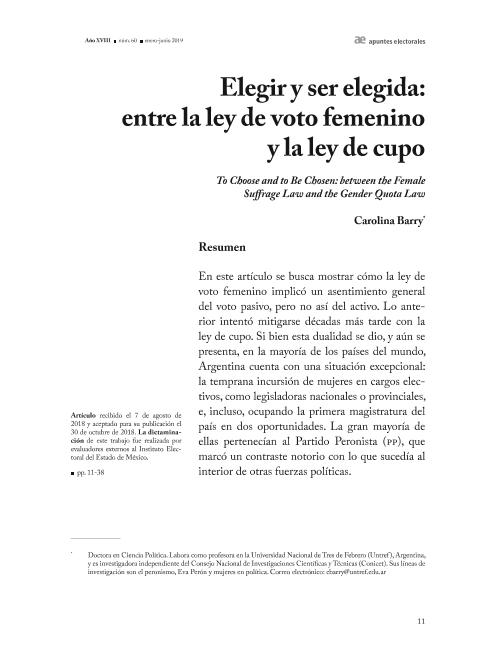Mostrar el registro sencillo del ítem
dc.contributor.author
Barry, Carolina Patricia

dc.date.available
2022-11-14T15:00:21Z
dc.date.issued
2018-11
dc.identifier.citation
Barry, Carolina Patricia; Elegir y ser elegida: entre la ley de Voto Femenino y la ley de Cupo; Instituto Electoral del Estado de México. Centro de Formación y Documentación Electoral; Apuntes Electorales; 18; 60; 11-2018; 11-38
dc.identifier.issn
2448-8585
dc.identifier.uri
http://hdl.handle.net/11336/177670
dc.description.abstract
En este artículo se busca mostrar cómo la ley de voto femenino implicó un asentimiento general del voto pasivo, pero no así del activo. Lo anterior intentó mitigarse décadas más tarde con la ley de cupo. Si bien esta dualidad se dio, y aún se presenta, en la mayoría de los países del mundo, Argentina cuenta con una situación excepcional: la temprana incursión de mujeres en cargos electivos, como legisladoras nacionales o provinciales, e, incluso, ocupando la primera magistratura del país en dos oportunidades. La gran mayoría de ellas pertenecían al Partido Peronista (PP), que marcó un contraste notorio con lo que sucedía al interior de otras fuerzas políticas.
dc.description.abstract
This article studies how the Female Suffrage Law implied a general ap-proval of the passive role of women in politics but not of an active one. This situation was partially mitigated when, decades after the approval of the Fe-male Suffrage Law, the Gender Quota Law for Legislative Candidates was passed. Even though the active/passive duality is present in most countries of the world, Argentina represents an exception due to the early election of women as national and provincial legislators. Moreover, Argentina had two female presidents. Most of these elected women came from the Peronist Party, which contrasts with what happened in the other political parties.
dc.format
application/pdf
dc.language.iso
spa
dc.publisher
Instituto Electoral del Estado de México. Centro de Formación y Documentación Electoral
dc.rights
info:eu-repo/semantics/openAccess
dc.rights.uri
https://creativecommons.org/licenses/by-nc-sa/2.5/ar/
dc.subject
ARGENTINA
dc.subject
LEY DE VOTO FEMENINO
dc.subject
LEY DE CUPO
dc.subject
PARLAMENTARIAS
dc.subject
PARTIDO PERONISTA
dc.subject.classification
Ciencias Sociales Interdisciplinarias

dc.subject.classification
Otras Ciencias Sociales

dc.subject.classification
CIENCIAS SOCIALES

dc.title
Elegir y ser elegida: entre la ley de Voto Femenino y la ley de Cupo
dc.title
To choose and to be xhosen: between the Female Suffrage Law and the Gender Quota Law
dc.type
info:eu-repo/semantics/article
dc.type
info:ar-repo/semantics/artículo
dc.type
info:eu-repo/semantics/publishedVersion
dc.date.updated
2022-11-14T11:25:12Z
dc.journal.volume
18
dc.journal.number
60
dc.journal.pagination
11-38
dc.journal.pais
México

dc.journal.ciudad
Ciudad de México
dc.description.fil
Fil: Barry, Carolina Patricia. Consejo Nacional de Investigaciones Científicas y Técnicas; Argentina. Universidad Nacional de Tres de Febrero; Argentina
dc.journal.title
Apuntes Electorales
dc.relation.alternativeid
info:eu-repo/semantics/altIdentifier/url/https://aelectorales.ieem.org.mx/index.php/ae/article/view/708
Archivos asociados
